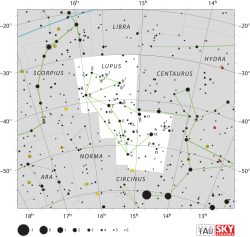Xi1 Lupi
| Xi1 Lupi (ξ1) | |
 | |
| Observationsdata Epok: J2000 | |
|---|---|
| Stjärnbild | Vargen |
| Rektascension | 15t 56m 53,49808s[1] |
| Deklination | -33° 57′ 58,0129″[1] |
| Skenbar magnitud () | 5,114[2] |
| Stjärntyp | |
| Spektraltyp | A3 V[3] |
| U–B | +0,069[2] |
| B–V | +0,116[2] |
| Astrometri | |
| Radialhastighet () | -10,0 ± 4,2[4] km/s |
| Egenrörelse (µ) | RA: +23,27[1] mas/år Dek.: -37,85[1] mas/år |
| Parallax () | 23,60 ± 3,48[1] |
| Avstånd | ca 140 ± 0,3 lå (ca 42 ± 0,09 pc) |
| Absolut magnitud () | +2,00[5] |
| Detaljer | |
| Massa | 2,01[6] M☉ |
| Radie | 1,80[5] R☉ |
| Luminositet | 12[7] L☉ |
| Temperatur | 9 206 ± 313[6] K |
| Vinkelhastighet | 78[6] km/s |
| Ålder | 237[6] miljoner år |
| Andra beteckningar | |
| ξ1 Lup, CD-33° 10826A, HD 142629, HIP 78105, HR 5925, SAO 207144, WDS J15569-3358A.[8] | |
Xi1 Lupi (ξ11 Lupi, förkortad Xi1 Lup, ξ1 Lup), som är stjärnans Bayer-beteckning, är en sannolik dubbelstjärna[9] i nordöstra delen av stjärnbilden Vargen där den bildar en visuell dubbelstjärna med Xi2 Lupi. Den har en magnitud av 5,11[2] och är synlig för blotta ögat där ljusföroreningar ej förekommer. Baserat på parallaxmätning inom Hipparcosuppdraget på ca 23,6 mas,[1] beräknas den befinna sig på ett avstånd av ca 140 ljusår (42 parsek) från solen. Xi1 Lupi ingår i Upper Scorpius-undergruppen i den närliggande Sco OB2-föreningen.[10]
Egenskaper
[redigera | redigera wikitext]Primärstjärnan Xi1 Lupi A är en blå till vit stjärna i huvudserien av spektralklass A3 V.[3] Den har en massa som är ca 2,0[6] gånger solens massa, en radie som är ca 1,8[5] gånger solens radie och avger ca 12[7] gånger mer energi än solen från dess fotosfär vid en effektiv temperatur på ca 9 200 K.[6]
Xi1 Lupi visar periodiska variationer i radialhastighet som bäst kan förklaras med att den utgör en spektroskopisk dubbelstjärna.[9]
Referenser
[redigera | redigera wikitext]- Den här artikeln är helt eller delvis baserad på material från engelskspråkiga Wikipedia, 6 februari 2019.
Noter
[redigera | redigera wikitext]- ^ [a b c d e f] van Leeuwen, F. (2007), "Validation of the new Hipparcos reduction", Astronomy and Astrophysics, 474 (2): 653–664, arXiv:0708.1752, Bibcode:2007A&A...474..653V, doi:10.1051/0004-6361:20078357.
- ^ [a b c d] Slawson, Robert W.; Hill, Robert J.; Landstreet, John D. (September 1992), "A homogeneous catalog of new UBV and H-beta photometry of B- and A-type stars in and around the Scorpius-Centaurus OB association", Astrophysical Journal Supplement Series, 82 (1): 117–144, Bibcode:1992ApJS...82..117S, doi:10.1086/191711.
- ^ [a b] Levato, H. (January 1975), "Rotational velocities and spectral types for a sample of binary systems", Astronomy and Astrophysics Supplement Series, 19: 91–99, Bibcode:1975A&AS...19...91L.
- ^ de Bruijne, J. H. J.; Eilers, A.-C. (October 2012), "Radial velocities for the HIPPARCOS-Gaia Hundred-Thousand-Proper-Motion project", Astronomy & Astrophysics, 546: 14, arXiv:1208.3048, Bibcode:2012A&A...546A..61D, doi:10.1051/0004-6361/201219219, A61.
- ^ [a b c] https://www.universeguide.com/star/xi1lupi. Hämtad 2019-02-06.
- ^ [a b c d e f] David, Trevor J.; Hillenbrand, Lynne A. (2015), "The Ages of Early-Type Stars: Strömgren Photometric Methods Calibrated, Validated, Tested, and Applied to Hosts and Prospective Hosts of Directly Imaged Exoplanets", The Astrophysical Journal, 804 (2): 146, arXiv:1501.03154, Bibcode:2015ApJ...804..146D, doi:10.1088/0004-637X/804/2/146.
- ^ [a b] McDonald, I.; et al. (2012), "Fundamental Parameters and Infrared Excesses of Hipparcos Stars", Monthly Notices of the Royal Astronomical Society, 427 (1): 343–57, arXiv:1208.2037, Bibcode:2012MNRAS.427..343M, doi:10.1111/j.1365-2966.2012.21873.x.
- ^ "ksi01 Lup". SIMBAD. Centre de données astronomiques de Strasbourg. Hämtad 2017-03-08.
- ^ [a b] Antonello, E.; et al. (January 2006), "Probable nonradial g-mode pulsation in early A-type stars", Astronomy and Astrophysics, 445 (1): L15–L18, arXiv:astro-ph/0511491, Bibcode:2006A&A...445L..15A, doi:10.1051/0004-6361:200500216.
- ^ Brown, A. G. A.; Verschueren, W. (March 1997), "High S/N Echelle spectroscopy in young stellar groups. II. Rotational velocities of early-type stars in SCO OB2", Astronomy and Astrophysics, 319: 811–838, arXiv:astro-ph/9608089, Bibcode:1997A&A...319..811B.





